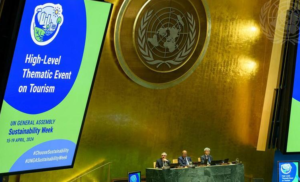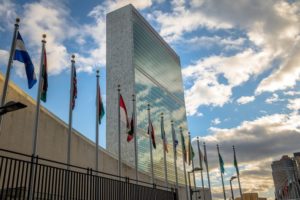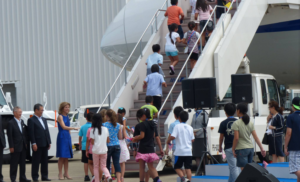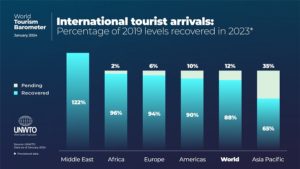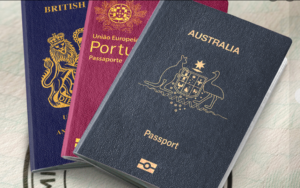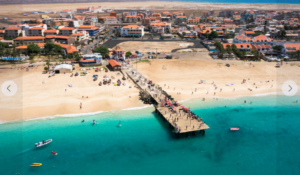29 sites added to UNESCO’s World Heritage List

Travel Biz News —
The World Heritage Committee inscribed 29 sites on UNESCO’s World Heritage List ending this year’s inscriptions on the list during its meeting in Baku recently.
The 43rd session of UNESCO’s World Heritage Committee considered 35 nominations this year and accepted 29 from around the world, some of them composed of multiple sites.
The newly inscribed sites are located in Italy , USA , Azerbaijan, Portugal, the Russian Federation, Spain, and the UK. Canada, Czechia, Germany, Republic of Korea, Myanmar and Poland Australia, Bahrain, China, India, Indonesia, Japan and People’s Democratic Republic of Lao , according to UNESCO .
The newly added sites are –
Le Colline del Prosecco di Conegliano e Valdobbiadene (Italy) — Located in north-eastern Italy, the site includes part of the vinegrowing landscape of the Prosecco wine production area. The landscape is characterized by ‘hogback’ hills, ciglioni – small plots of vines on narrow grassy terraces – forests, small villages and farmland.
The 20th century Architecture of Frank Lloyd Wright (United States of America) – The property consists of eight buildings in the United States designed by the architect during the first half of the 20th century. These include the Fallingwater (Mill Run, Pennsylvania), the Herbert and Katherine Jacobs House (Madison, Wisconsin) and the Guggenheim Museum (New York).
Royal Building of Mafra—Palace, Basilica, Convent, Cerco Garden and Hunting Park (Tapada) (Portugal) — Located 30 km northwest of Lisbon, the site was conceived by King João V in 1711 as a tangible representation of his conception of the monarchy and the State. This imposing quadrangular building houses the king’s and queen’s palaces, the royal chapel, shaped like a Roman baroque basilica, a Franciscan monastery and a library containing 36,000 volumes.
Sanctuary of Bom Jesus do Monte in Braga (Portugal) — The site, a cultural landscape located on the slopes of Mount Espinho, overlooking the city of Braga in the north of Portugal, evokes Christian Jerusalem, recreating a sacred mount crowned with a church.
Churches of the Pskov School of Architecture (Russian Federation) — Churches, cathedrals, monasteries, fortification towers and administrative buildings make up the site, a group of monuments located in the historic city of Pskov, on the banks of the Velikaya River in the northwest of Russia.
Risco Caido and the Sacred Mountains of Gran Canaria Cultural Landscape (Spain) — Located in a vast mountainous area in the centre of Gran Canaria, Risco Caído comprises cliffs, ravines and volcanic formations in a landscape of rich biodiversity.
Jodrell Bank Observatory (United Kingdom of Great Britain and Northern Ireland) — Located in a rural area of northwest England, free from radio interference, Jodrell Bank is one of the world’s leading radio astronomy observatories. At the beginning of its use, in 1945, the site housed research on cosmic rays detected by radar echoes.
Historic Centre of Sheki with the Khan’s Palace (Azerbaijan) — The historic city of Sheki is located at the foot of the Greater Caucasus Mountains and divided in two by the Gurjana River.
Bagan (Myanmar) — Lying on a bend of the Ayeyarwady River in the central plain of Myanmar, Bagan is a sacred landscape, featuring an exceptional range of Buddhist art and architecture.
Seowon, Korean Neo-Confucian Academies (Republic of Korea) — This site, located in central and southern parts of the Republic of Korea, comprises nine seowon, representing a type of Neo-Confucian academy of the Joseon dynasty (15th—19th centuries CE). Learning, veneration of scholars and interaction with the environment were the essential functions of the seowons, expressed in their design.
Writing-on-Stone / Áísínai’pi (Canada) — This site is located on the northern edge of the semi-arid Great Plains of North America, on the border between Canada and the United States of America.
Erzgebirge/Krušnohoří Mining Region (Czechia/Germany) — Erzgebirge/Krušnohoří (Ore Mountains) spans a region in south-eastern Germany (Saxony) and north-western Czechia, which contains a wealth of several metals exploited through mining from the Middle Ages onwards.
Landscape for Breeding and Training of Ceremonial Carriage Horses at Kladruby nad Labem (Czechia) — Situated in the Střední Polabí area of the Elbe plain, the site consists of flat, sandy soils and includes fields, fenced pastures, a forested area and buildings, all designed with the main objective of breeding and training kladruber horses, a type of draft horse used in ceremonies by the Habsburg imperial court.
Water Management System of Augsburg (Germany) — The water management system of the city of Augsburg has evolved in successive phases from the 14th century to the present day.
Krzemionki Prehistoric Striped Flint Mining Region — (Poland) – Located in the mountain region of Świętokrzyskie, Krzemionki is an ensemble of four mining sites, dating from the Neolithic to the Bronze Age (about 3900 to 1600 BCE), dedicated to the extraction and processing of striped flint, which was mainly used for axe-making.
Dilmun Burial Mounds (Bahrain) — The Dilmun Burial Mounds, built between 2050 and 1750 BCE, span over 21 archaeological sites in the western part of the island. Six of these sites are burial mound fields consisting of a few dozen to several thousand tumuli.
Budj Bim Cultural Landscape (Australia) — Located within the Country of the Gunditjmara, an Aboriginal nation in the southwest of Australia, the property includes the Budj Bim Volcano and Tae Rak (Lake Condah), as well as the Kurtonitj component, characterized by wetland swamps, and Tyrendarra in the south, an area of rocky ridges and large marshes.
Archaeological Ruins of Liangzhu City (China) — Located in the Yangtze River Basin on the south-eastern coast of the country, the archaeological ruins of Liangzhu (about 3300-2300 BCE) reveal an early regional state with a unified belief system based on rice cultivation in Late Neolithic China.
Jaipur City, Rajasthan (India) — The fortified city of Jaipur, in India’s northwestern state of Rajasthan was founded in 1727 by Sawai Jai Singh II. Unlike other cities in the region located in hilly terrain, Jaipur was established on the plain and built according to a grid plan interpreted in the light of Vedic architecture.
Ombilin Coal Mining Heritage of Sawahlunto, (Indonesia) — Built for the extraction, processing and transport of high-quality coal in an inaccessible region of Sumatra, this industrial site was developed by the Netherlands’ colonial government from the late 19th to the beginning of the 20th century with a workforce recruited from the local population and supplemented by convict labour from Dutch-controlled areas.
Mozu-Furuichi Kofun Group: Mounded Tombs of Ancient Japan (Japan) — Located on a plateau above the Osaka Plain, this property includes 49 kofun (old mounds in Japanese). Burial mounds of various sizes, kofun can take the form of key holes, scallops, squares or circles.
Megalithic Jar Sites in Xiengkhouang — Plain of Jars (Lao People’s Democratic Republic) — The Plain of Jars, located on a plateau in central Laos, gets its name from more than 2,100 tubular-shaped megalithic stone jars used for funerary practices in the Iron Age.
Migratory Bird Sanctuaries along the Coast of Yellow Sea-Bohai Gulf of China (Phase I) (China)—The site features an intertidal mudflat system considered to be the largest in the world. These mudflats, as well as marshes and shoals, are exceptionally productive and serve as growth areas for many species of fish and crustaceans.
Hyrcanian Forests (Islamic Republic of Iran) – Hyrcanian forests form a unique forested massif that stretches 850 km along the southern coast of the Caspian Sea.
French Austral Lands and Seas (France) — The French Austral Lands and Seas comprise the largest of the rare emerged land masses in the southern Indian Ocean: the Crozet Archipelago, the Kerguelen Islands, Saint-Paul and Amsterdam Islands as well as 60 small sub-Antarctic islands.
Vatnajökull National Park – dynamic nature of fire and ice (Iceland) — This iconic volcanic region covers an area of over 1,400,000 ha, nearly 14% of Iceland’s territory. It numbers ten central volcanoes, eight of which are subglacial.
Paraty and Ilha Grande – Culture and Biodiversity (Brazil) – Located between the Serra da Bocaina mountain range and the Atlantic Ocean, this cultural landscape includes the historic centre of Paraty, one of Brazil’s best-preserved coastal towns, as well as four protected natural areas of the Brazilian Atlantic Forest, one of the world’s five key biodiversity hotspots.
Ancient Ferrous Metallurgy Sites of Burkina Faso (Burkina Faso) – This property is composed of five elements located in different provinces of the country. It includes about fifteen standing, natural-draught furnaces, several other furnace structures, mines and traces of dwellings.
Babylon (Iraq) – Situated 85 km south of Baghdad, the property includes the ruins of the city which, between 626 and 539 BCE, was the capital of the Neo-Babylonian Empire. It includes villages and agricultural areas surrounding the ancient city.
Extension:
Natural and Cultural Heritage of the Ohrid region (Albania) [extension of “Natural and Cultural Heritage of the Ohrid region”, North Macedonia] – The part of Lake Ohrid located in Northern Macedonia and its hinterland, including the town of Ohrid, has been inscribed on the World Heritage List since 1979. Source : UNESCO WHC
July 8 , 2019
Photo : San Martino mountain pass, Le Colline del Prosecco di Conegliano e Valdobbiadene World Heritage site (Italy). © Consorzio Tutela del Vino Conegliano Valdobbiadene Prosecco Superiore Docg / Arcangelo Piai fotografo/ UNESCO

